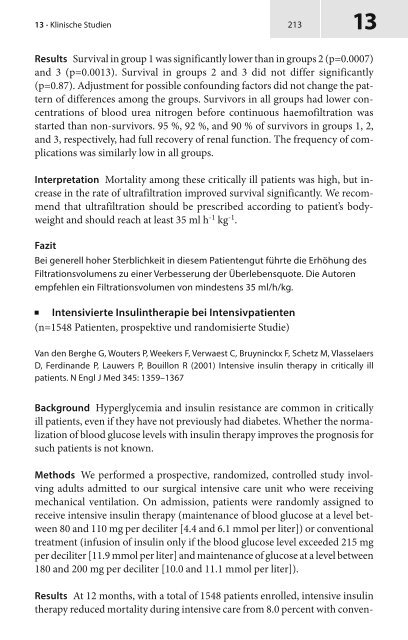Intensivmedizin Fragen und Antworten
Erfolgreiche ePaper selbst erstellen
Machen Sie aus Ihren PDF Publikationen ein blätterbares Flipbook mit unserer einzigartigen Google optimierten e-Paper Software.
13 · Klinische Studien<br />
213<br />
13<br />
Results Survival in group 1 was significantly lower than in groups 2 (p=0.0007)<br />
and 3 (p=0.0013). Survival in groups 2 and 3 did not differ significantly<br />
(p=0.87). Adjustment for possible confo<strong>und</strong>ing factors did not change the pattern<br />
of differences among the groups. Survivors in all groups had lower concentrations<br />
of blood urea nitrogen before continuous haemofiltration was<br />
started than non-survivors. 95 %, 92 %, and 90 % of survivors in groups 1, 2,<br />
and 3, respectively, had full recovery of renal function. The frequency of complications<br />
was similarly low in all groups.<br />
Interpretation Mortality among these critically ill patients was high, but increase<br />
in the rate of ultrafiltration improved survival significantly. We recommend<br />
that ultrafiltration should be prescribed according to patient’s bodyweight<br />
and should reach at least 35 ml h -1 kg -1 .<br />
Fazit<br />
Bei generell hoher Sterblichkeit in diesem Patientengut führte die Erhöhung des<br />
Filtrationsvolumens zu einer Verbesserung der Überlebensquote. Die Autoren<br />
empfehlen ein Filtrationsvolumen von mindestens 35 ml/h/kg.<br />
jIntensivierte Insulintherapie bei Intensivpatienten<br />
(n=1548 Patienten, prospektive <strong>und</strong> randomisierte Studie)<br />
Van den Berghe G, Wouters P, Weekers F, Verwaest C, Bruyninckx F, Schetz M, Vlasselaers<br />
D, Ferdinande P, Lauwers P, Bouillon R (2001) Intensive insulin therapy in critically ill<br />
patients. N Engl J Med 345: 1359–1367<br />
Backgro<strong>und</strong> Hyperglycemia and insulin resistance are common in critically<br />
ill patients, even if they have not previously had diabetes. Whether the normalization<br />
of blood glucose levels with insulin therapy improves the prognosis for<br />
such patients is not known.<br />
Methods We performed a prospective, randomized, controlled study involving<br />
adults admitted to our surgical intensive care unit who were receiving<br />
mechanical ventilation. On admission, patients were randomly assigned to<br />
receive intensive insulin therapy (maintenance of blood glucose at a level between<br />
80 and 110 mg per deciliter [4.4 and 6.1 mmol per liter]) or conventional<br />
treatment (infusion of insulin only if the blood glucose level exceeded 215 mg<br />
per deciliter [11.9 mmol per liter] and maintenance of glucose at a level between<br />
180 and 200 mg per deciliter [10.0 and 11.1 mmol per liter]).<br />
Results At 12 months, with a total of 1548 patients enrolled, intensive insulin<br />
therapy reduced mortality during intensive care from 8.0 percent with conven-


